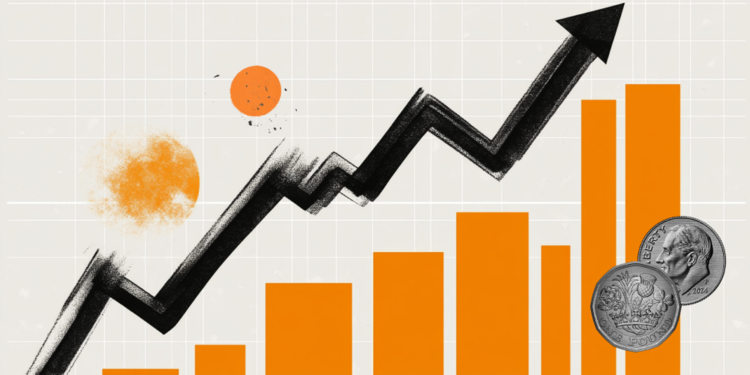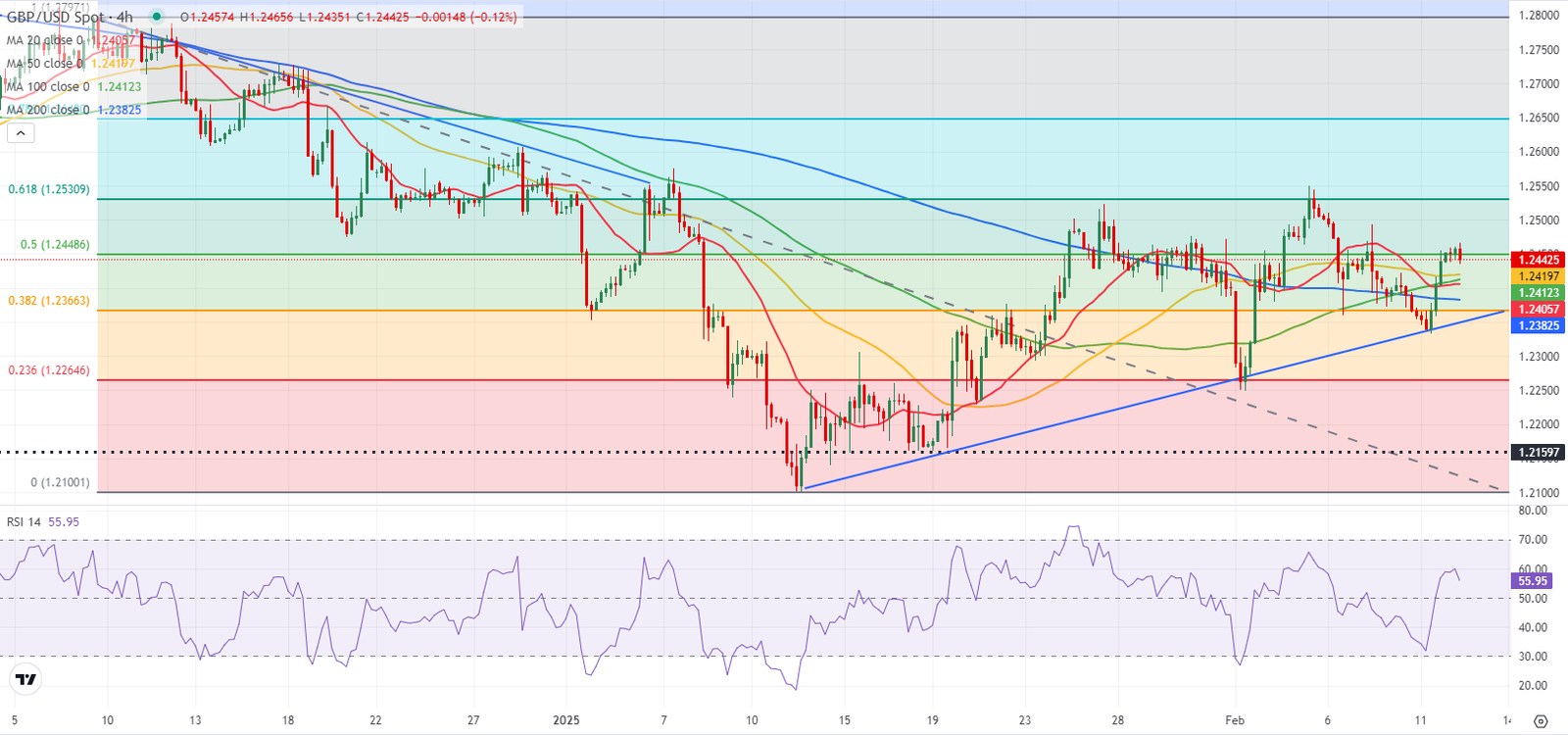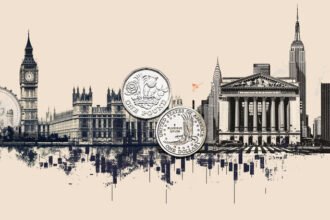- GBP/USD holds near 1.2450 after posting strong gains on Tuesday.
- The technical picture highlights sellers’ hesitancy in the near term.
- The US economic calendar will feature January inflation data.
Following the bearish action seen at the beginning of the week, GBP/USD reversed its direction on Tuesday and gained more than 0.6%. Ahead of the key January inflation data from the US, the pair holds above key technical area.
British Pound PRICE This week
The table below shows the percentage change of British Pound (GBP) against listed major currencies this week. British Pound was the strongest against the Japanese Yen.
| USD | EUR | GBP | JPY | CAD | AUD | NZD | CHF | |
|---|---|---|---|---|---|---|---|---|
| USD | -0.41% | -0.37% | 1.46% | 0.16% | -0.06% | 0.37% | 0.14% | |
| EUR | 0.41% | 0.11% | 1.99% | 0.69% | 0.35% | 0.87% | 0.64% | |
| GBP | 0.37% | -0.11% | 1.72% | 0.55% | 0.24% | 0.76% | 0.52% | |
| JPY | -1.46% | -1.99% | -1.72% | -1.32% | -1.43% | -1.07% | -1.28% | |
| CAD | -0.16% | -0.69% | -0.55% | 1.32% | -0.19% | 0.18% | -0.04% | |
| AUD | 0.06% | -0.35% | -0.24% | 1.43% | 0.19% | 0.52% | 0.28% | |
| NZD | -0.37% | -0.87% | -0.76% | 1.07% | -0.18% | -0.52% | -0.24% | |
| CHF | -0.14% | -0.64% | -0.52% | 1.28% | 0.04% | -0.28% | 0.24% |
The heat map shows percentage changes of major currencies against each other. The base currency is picked from the left column, while the quote currency is picked from the top row. For example, if you pick the British Pound from the left column and move along the horizontal line to the US Dollar, the percentage change displayed in the box will represent GBP (base)/USD (quote).
The US Dollar (USD) came under selling pressure on Tuesday, allowing GBP/USD gain traction. The lack of fresh headlines surrounding US President Donald Trump’s trade policy and Federal Reserve (Fed) Chairman Jerome Powell’s hesitancy to offer fresh insight into the policy outlook helped market mood improve in the American session.
On the first day of his congressional testimony on the semi-annual Monetary Policy Report, Powell repeated that they do not need to be in a hurry to adjust the monetary policy. He added that it’s not for the Fed to comment on tariffs and explained that they will follow incoming data to assess the effects of the trade policy.
In the second half of the day, January Consumer Price Index (CPI) data from the US will be watched closely by market participants. On a monthly basis, the core CPI, which excludes volatile food and energy prices, is forecast to rise 0.3%. A stronger increase than expected could support the USD with the initial reaction and cause GBP/USD to turn south. Conversely, a soft monthly core inflation reading of 0.2% or lower could have the opposite impact on the pair’s action.
Early Thursday, the UK’s Office for National Statistics (ONS) will publish the Gross Domestic Product (GDP) data for the fourth quarter.
GBP/USD Technical Analysis
GBP/USD holds comfortably above the ascending trend line and the 200-period and the 100-period Simple Moving Averages (SMA), reflecting the bullish bias. Additionally, the Relative Strength Index (RSI) indicator on the 4-hour chart stays above 50.
In case GBP/USD confirms 1.2450 (Fibonacci 50% retracement of the latest downtrend) as support, it could target 1.2500 (round level, static level) and 1.2530 (Fibonacci 61.8% retracement) next. On the downside, supports could be seen at 1.2415 (100-period SMA) and 1.2380-1.2370 (200-period SMA, Fibonacci 38.2% retracement, ascending trend line).
Pound Sterling FAQs
The Pound Sterling (GBP) is the oldest currency in the world (886 AD) and the official currency of the United Kingdom. It is the fourth most traded unit for foreign exchange (FX) in the world, accounting for 12% of all transactions, averaging $630 billion a day, according to 2022 data. Its key trading pairs are GBP/USD, also known as ‘Cable’, which accounts for 11% of FX, GBP/JPY, or the ‘Dragon’ as it is known by traders (3%), and EUR/GBP (2%). The Pound Sterling is issued by the Bank of England (BoE).
The single most important factor influencing the value of the Pound Sterling is monetary policy decided by the Bank of England. The BoE bases its decisions on whether it has achieved its primary goal of “price stability” – a steady inflation rate of around 2%. Its primary tool for achieving this is the adjustment of interest rates. When inflation is too high, the BoE will try to rein it in by raising interest rates, making it more expensive for people and businesses to access credit. This is generally positive for GBP, as higher interest rates make the UK a more attractive place for global investors to park their money. When inflation falls too low it is a sign economic growth is slowing. In this scenario, the BoE will consider lowering interest rates to cheapen credit so businesses will borrow more to invest in growth-generating projects.
Data releases gauge the health of the economy and can impact the value of the Pound Sterling. Indicators such as GDP, Manufacturing and Services PMIs, and employment can all influence the direction of the GBP. A strong economy is good for Sterling. Not only does it attract more foreign investment but it may encourage the BoE to put up interest rates, which will directly strengthen GBP. Otherwise, if economic data is weak, the Pound Sterling is likely to fall.
Another significant data release for the Pound Sterling is the Trade Balance. This indicator measures the difference between what a country earns from its exports and what it spends on imports over a given period. If a country produces highly sought-after exports, its currency will benefit purely from the extra demand created from foreign buyers seeking to purchase these goods. Therefore, a positive net Trade Balance strengthens a currency and vice versa for a negative balance.






















